This 15-minute homemade hot sauce recipe tastes just like Frank’s Hot Sauce. Using just 4 ingredients, you’ll have a delicious hot sauce that’s mild, medium, or hot – however you want!
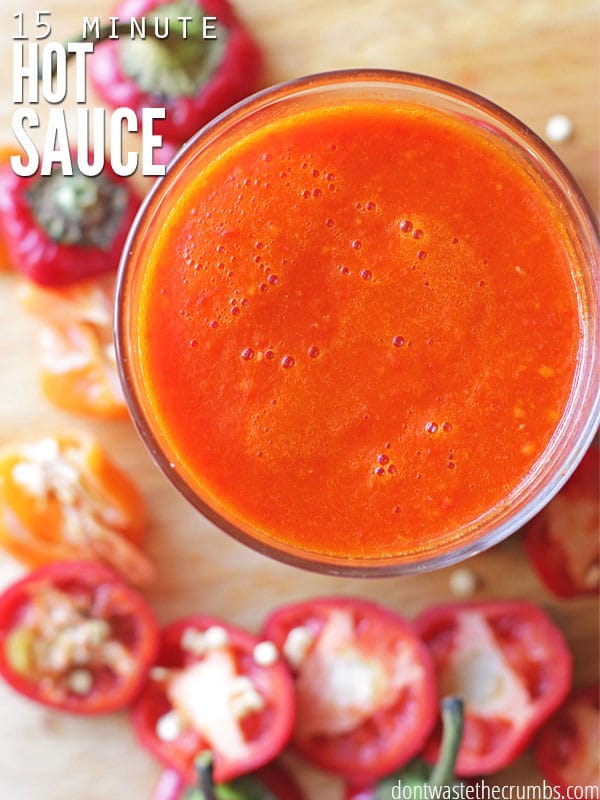
I’m by no means a gardening expert and I’m lucky if my plants make it halfway through the season, but for some reason, hot pepper plants thrive even with my neglect.
I planted 3 plants this year – just to see what would happen – and ended up with more peppers than I knew what to do with.
My husband is a huge fan of spicy food and Frank’s hot sauce is high on the list (hence his love for Buffalo Chicken Pizza), so I ventured to come up with my own hot sauce recipe that would taste just like it using the peppers from our garden.
And boy, did I succeed! This Frank’s copycat hot sauce recipe has just the right amount of heat.

SIMPLE HOT SAUCE RECIPE
Hot sauce is a great way to add a lot of flavor to your food! It’s also:
- Quick and easy. If you’re looking for an easy hot sauce recipe, this is it. There is minimal prep work, a short boil, and a quick whirl in the blender. Ready in less than 15 minutes.
- Delicious! This homemade hot sauce rivals anything from the store.
- Frugal. Making hot sauce is cheap, especially if you grow your own peppers.
- Made with simple ingredients. Aside from the peppers, you need just 3 pantry staples for this hot pepper sauce recipe.
- Adaptable. Make it as mild or as hot as you can handle.
COPYCAT FRANK’S HOT PEPPER SAUCE RECIPE INGREDIENTS
If you want to make this hot pepper sauce recipe that’s a copycat of Frank’s Hot Sauce, you’ll need:
Psst…Did you know that many salts contain MICROPLASTICS? It’s a sneaky toxin that may be in your everyday salt, and thus your everyday food (um, gross). I love Ava Jane’s Kitchen because their salt is FREE of microplastics, and it tastes delicious! (PLUS, you can get a free 8oz. bag of sea salt – just pay shipping and handling!)
Keep reading if you want to use a different pepper or are considering adding fruits like peaches or mangoes to your hot sauce! You’ll notice I don’t add any spices to the mixture like cumin or chili powder. We really like the depth of flavor of the peppers to shine!
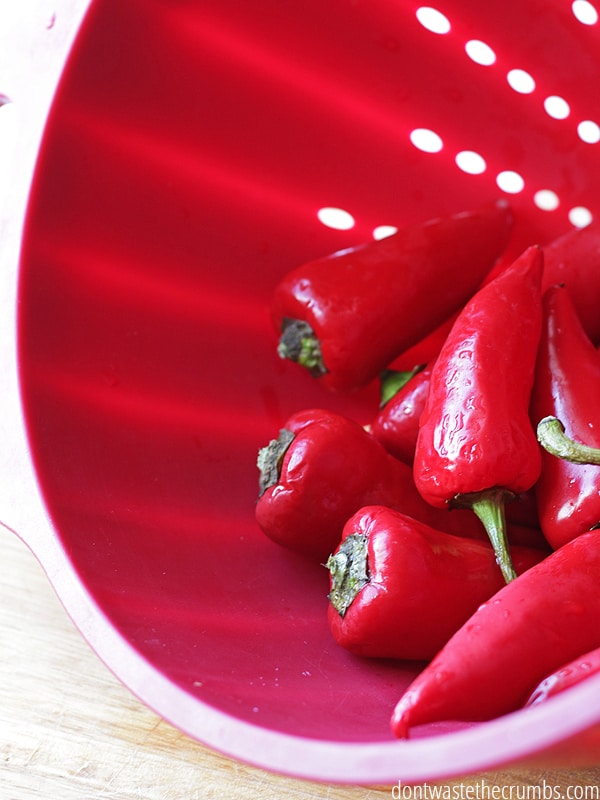
CHOOSING PEPPERS FOR HOT PEPPER SAUCE RECIPES
You’ll want to use cayenne peppers to make your own copycat of Frank’s, but you can use different types of hot peppers if you want. I used Fresno chili peppers for these photos because that’s what I had an abundance of and I didn’t want to ruin my tastebuds for the rest of the day.
Fresno is generally a mild pepper, ranging from 2500 to 10,000 on the Scoville scale (similar to jalapenos). I added in some habanero for some heat.
Use the heat index below to determine which peppers are best for your hot pepper sauce recipes. The heat of a pepper is measured in Scoville Heat Units, which is how “hot” the pepper actually is. The higher the Scoville, the hotter the pepper.
If you’re unsure what fresh peppers to use, choose a pepper that’s on the mild side and then boost the heat with one or two peppers on the hotter side. You can easily add a quarter or half of a habanero pepper or scotch bonnet pepper and then taste as you go.
Also, the color of your hot sauce will depend on the color of your peppers. If you want a red hot sauce, you’ll want to choose peppers that are orange or red. Green peppers will create a green hot sauce. Adding a few red bell peppers can help add color without extra heat.
I do not recommend using dried peppers for this recipe. You need the natural liquids in the peppers to create the sauce.
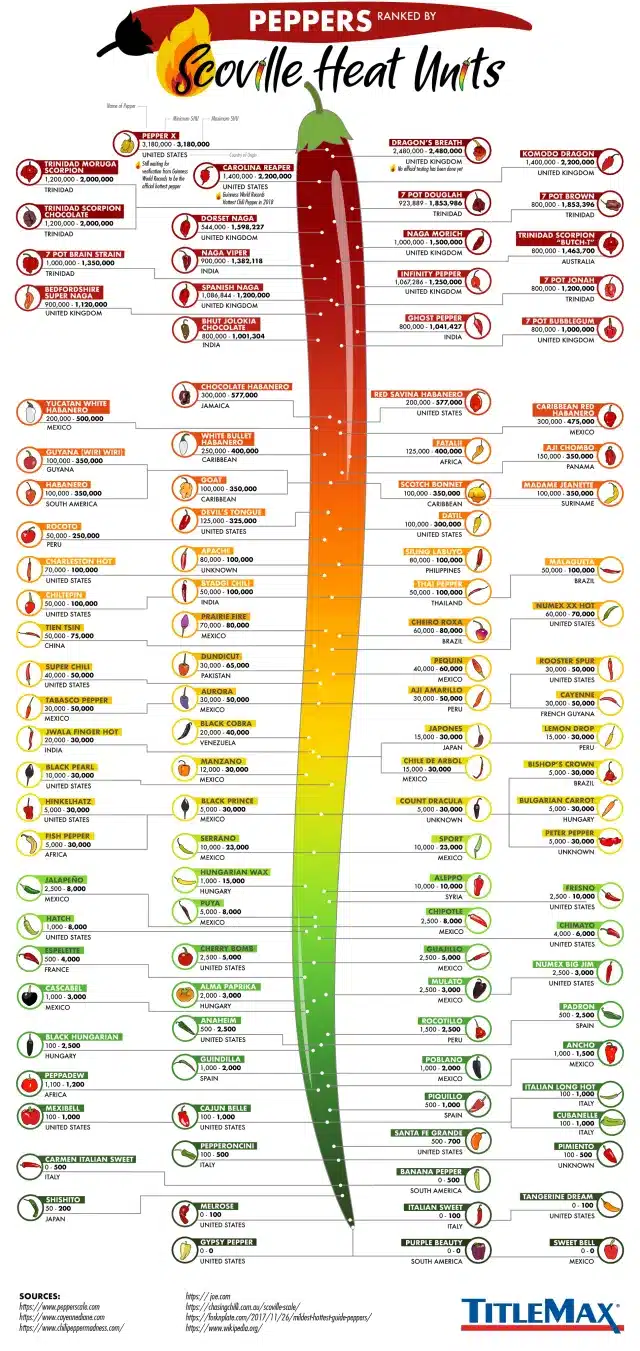
Image courtesy of Title Max.
BEFORE YOU MAKE THE BEST RECIPE OF HOT SAUCE
Any time you work with hot peppers – whether they’re mild or truly hot – you have to take safety precautions:
- Wear food-grade gloves when handling the peppers. This includes washing, cutting, and even scraping scraps into compost or trash can. Putting gloves on is the first thing I do, and I don’t take them off until the dishwasher is loaded.
- Wear goggles and work in a well-ventilated area. An open kitchen window and swim goggles will do the trick. Avoid small, closet-type spaces without air circulation, especially when working with very hot peppers.
- Wash your hands extremely well after handling the peppers.
- Wash all utensils well when you’re done – cutting boards, knives, spoons, blender jar, etc. I use a plastic cutting board so I can run everything through the dishwasher.
I’m going to say it again, wear gloves to handle the peppers. The oils from the peppers can rub off onto your hands without you even knowing it, and without you having an adverse reaction…that is until you scratch your nose or wipe your eye. The oils can easily transfer from the surface of your skin and cause all sorts of irritation in places you don’t want to be irritated!
If you wear contacts, be sure to take them out before making this recipe of hot sauce!
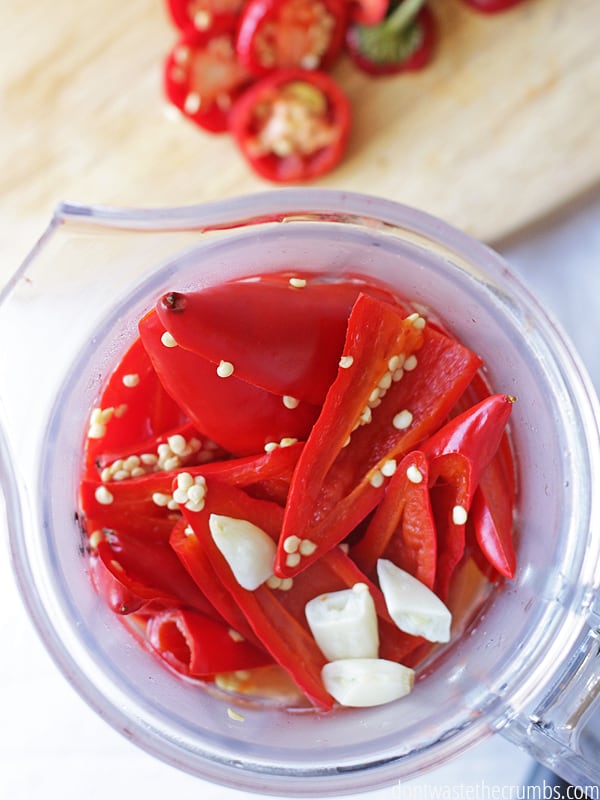
HOW TO MAKE HOT SAUCE
Here are the instructions for how to make hot sauce, and you’ll see it’s VERY easy!
Step 1: Wash the peppers, cut the stems off, and slice them in half lengthwise. If you want a milder sauce, remove the seeds from the pepper. This will also create a smoother sauce. If you don’t mind a few tiny pieces of seed and want extra heat, keep the seeds with the pepper.
Step 2: Measure the vinegar into a medium pot and add the peppers, salt, and garlic cloves. Bring to a boil and reduce heat to a simmer until the peppers are soft (about 10 minutes).
Step 3: Pour everything into your blender (I use a Blendtec like this one), including peppers and vinegar. Blend until you have a smooth texture puree, about 30-60 seconds.
Note: Red peppers will temporarily dye plastic blender jars red. A couple of washes with hot soapy water will remove the discoloration.
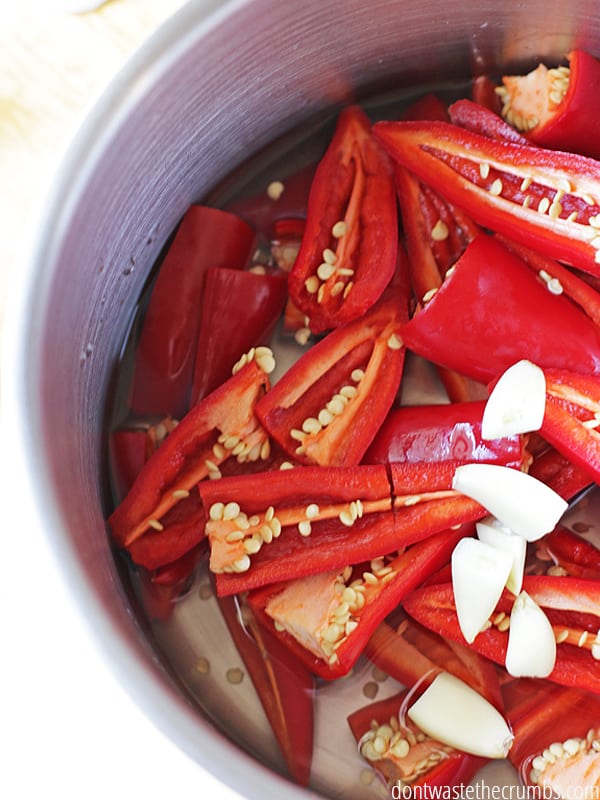
Step 4: Taste the homemade hot sauce and add additional hot peppers if desired. I recommend adding ¼ of a hot pepper (like Habanero or scotch bonnet) at a time, reblending with each addition and tasting as you go. The hot sauce will have a more intense flavor as it sits, but it will not get hotter. Here’s your chance to get the heat level just right.
Step 5: Let the hot sauce cool. Transfer to a mason jar using a funnel and store it in your fridge. The abundance of vinegar acts like a natural preservative for several weeks. If you prefer, canning your hot sauce in mason jars is an option to make it shelf-stable.
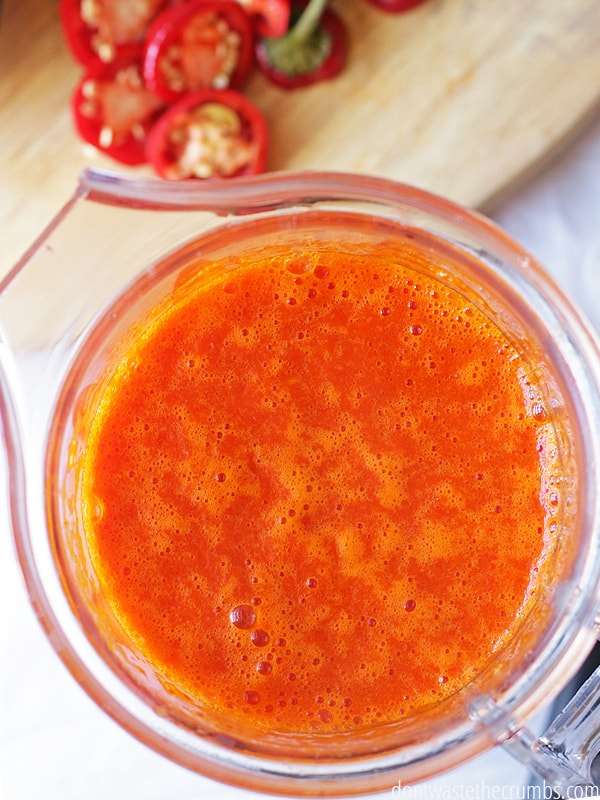
TO SERVE THIS HOT SAUCE RECIPE
We love using our homemade hot sauce as a condiment for all sorts of things!
- Pour a bit of hot sauce over Scrambled Eggs and Oven-Roasted Hash Browns for a yummy breakfast with a kick
- Use as a dip for Chicken Nuggets or Almond-Crusted Chicken
- Drizzle on pizza as a finishing sauce – yum!
- Top Baked Potatoes or Crispy Potato Wedges or Fries
- Add to your favorite salad, like this Buffalo Chicken Salad or this Southwestern Salad
- And of course use it on tacos!
VARIATIONS FOR HOMEMADE HOT SAUCE RECIPE
Make it Thicker or Thinner: Some peppers naturally contain more pulp while others contain more water. After you’ve blended the sauce, you can strain out the pulp with a fine-mesh strainer for a more watery hot sauce or leave the pulp in for a thicker hot sauce. Adding a little bit of filtered water will thin it as well.
Keep the Seeds or Toss Them: Keeping the seeds will make your homemade hot sauce hotter, and removing the seeds will remove some of the heat. You can go either way!
Change the Color: The color of the hot sauce will depend on the color of the peppers you use. Green chilies will make a green hot sauce, while orange/red chilies will make a red sauce. Combine red and green chilies for a brown sauce.
Make it Sweeter: Give your hot sauce recipe a bit of sweetness by choosing a pepper that has sweetness or add a bit of honey or sugar. A little sweetness goes a long way, so add ½ tsp at a time and taste as you go.
Roast the Peppers: Roasting the peppers before you cook them in vinegar gives the peppers a smokey flavor. This is optional, but it’s a lot of fun to experiment with flavors!
Turn it into Buffalo Sauce: Traditional buffalo sauce is slightly thicker with buttery notes. Use this recipe to make the Best Buffalo Sauce with your homemade hot sauce!
We love this buffalo wing sauce recipe so much, and we’ve found several fun ways to enjoy it:
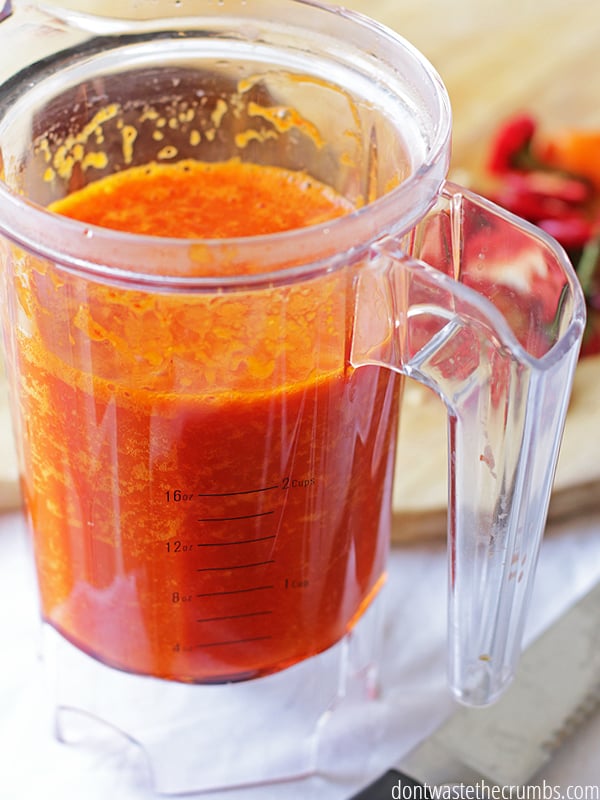
UNIQUE HOT PEPPER SAUCE RECIPES
In addition to the variations above, you can create unique hot pepper sauce recipes by adding other fruits and vegetables:
Consider adding garlic, onion, and carrots to balance the flavor of the mild hot sauces. Fruits like mango, peach, pineapple, blueberries, cherries, and apples are nice additions to hotter peppers. Add a little bit of lime juice for a twist!
You can also vary the heat in your homemade hot sauce by switching up the peppers and add-ins.
Mild to Medium Hot Sauce: Try jalapenos, serrano chili peppers, cherry bomb peppers, banana peppers, or Fresno peppers.
Medium to Hot Sauce: Try cayenne chili peppers, fish peppers, Thai chilies, or Tabasco peppers. Adding peaches or mango would be a unique way to balance the flavor.
Hot to Crazy Hot Sauce: Try habanero, scotch bonnet, or ghost peppers. Remember that these are VERY hot peppers, so consider balancing these out with some milder chiles.
FERMENTED HOT SAUCE RECIPE VS COOKED HOT SAUCE RECIPE
Traditionally, fermented hot sauce requires the peppers to be fully submerged in brine and left to ferment for up to two weeks, sometimes longer.
I typically don’t follow this fermentation process because I’m impatient, and not a massive fan of the fermented version of hot sauce. I much prefer the 15-minute hot sauce recipe I’ve outlined here to have hot sauce ready whenever I want!
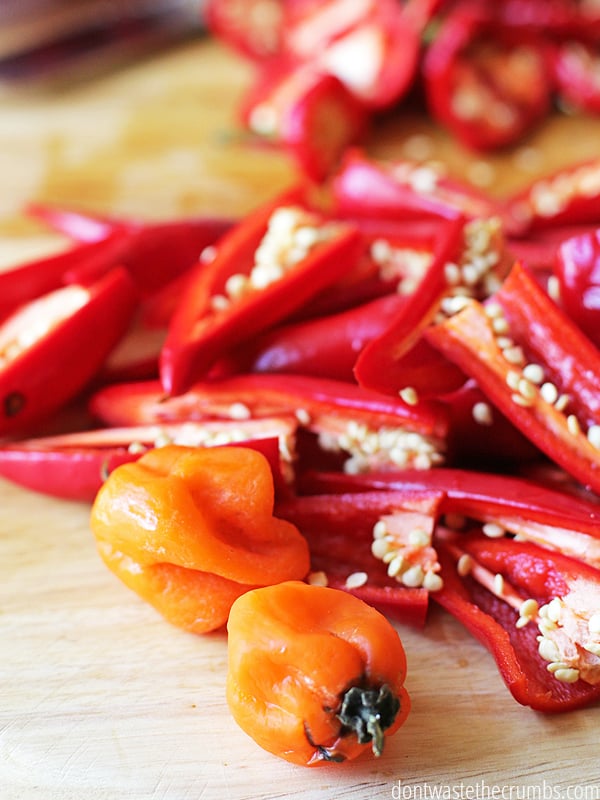
HOT PEPPER SAUCE RECIPE FAQS
Should I use a blender or a food processor for homemade hot sauce?
I’ve found that using a Blender (I have a Blendtec) is the easiest method to make hot sauce, but you can also use a medium to large-capacity food processor like this one. Another option is to use an immersion blender. If you use an immersion blender, let the hot sauce cool to room temperature so you don’t risk splashing hot liquid on yourself!
Which vinegar is best for homemade hot sauce?
I used white vinegar, but you can substitute apple cider vinegar. It would add a subtle sweet flavor to your hot sauce!
How long will homemade hot sauce last?
My cooked hot sauce has a 2-4 week shelf life in the fridge, and if you go the fermented route, it’ll last 3-6 months. Remember that hot sauce will tint your storage container, so I re-purpose glass jars from jelly or spaghetti to prevent any plastic items from discoloring. Reusing old hot sauce bottles from store-bought hot sauce works too!
Can I freeze homemade hot sauce?
Yes, you can freeze the hot sauce for up to 3 months. I recommend using zip-sealed freezer bags (I use these reusable freezer-safe bags), although you can safely freeze in glass jars too. Thaw in the refrigerator and then give it a good stir in case the sauce has separated from freezing.
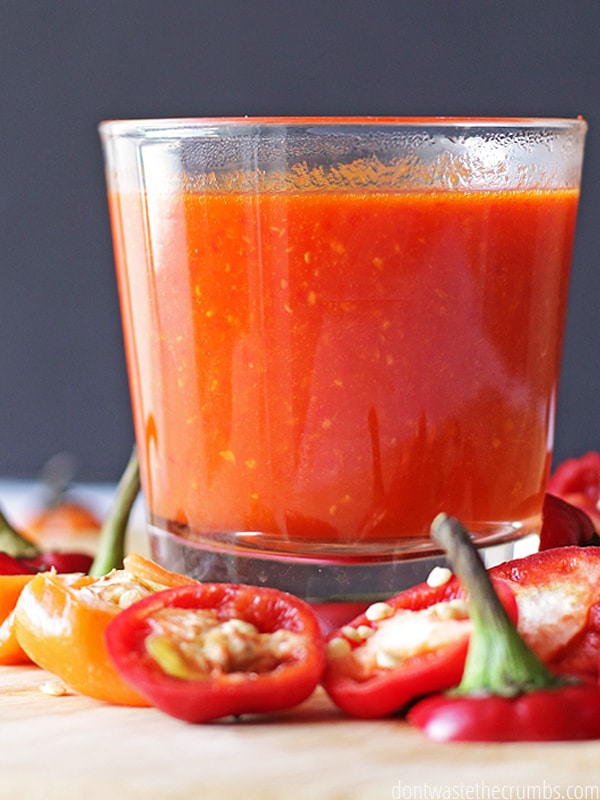
MORE EASY HOMEMADE SAUCES
- Homemade Red Enchilada Sauce
- Homemade Buffalo Wing Sauce
- 15-Minute Spaghetti Sauce
- Easy Pizza Sauce
- Homemade Sweet and Sour Sauce
- Thai Peanut Sauce
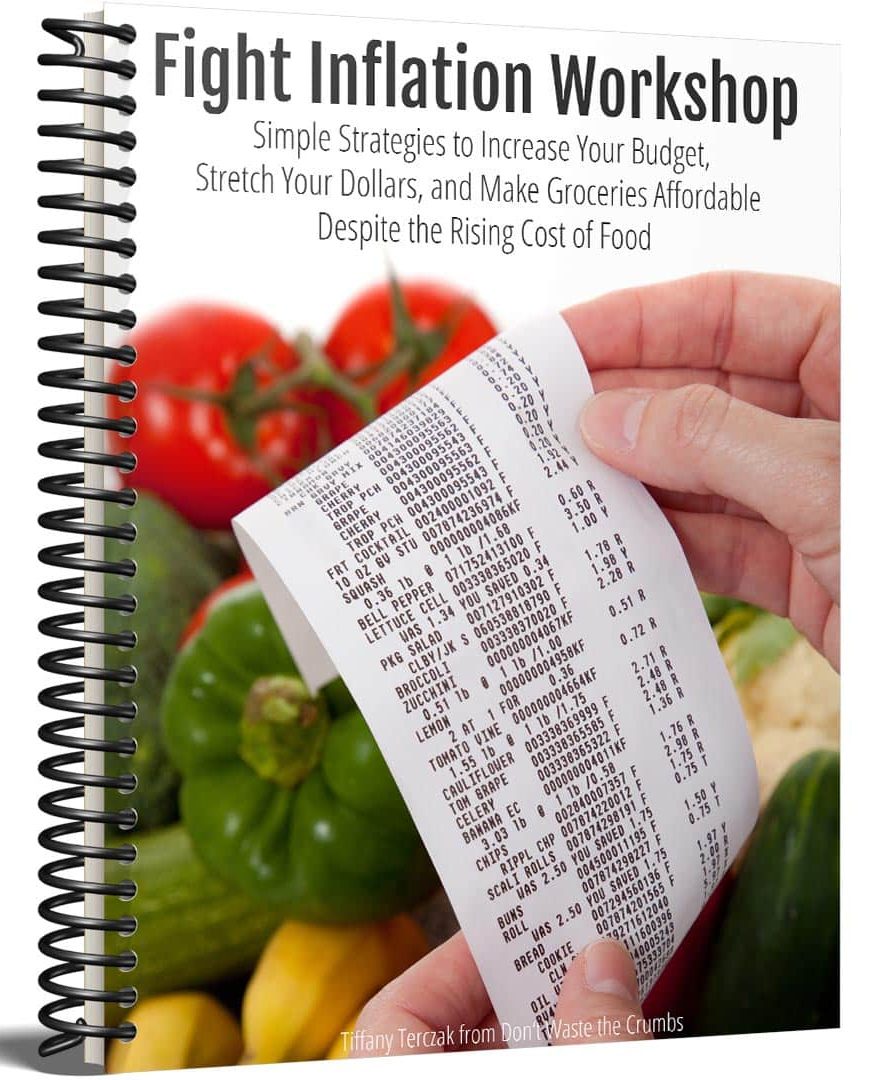
Fight Inflation Workshop!
Sign up for my FREE Fight Inflation Workshop and learn simple strategies to save money, even with rising food costs!WATCH HOW TO MAKE 15 MINUTE HOT SAUCE
15 Minute Homemade Hot Sauce
This 15-minute homemade hot sauce recipe tastes just like Frank’s Hot Sauce. Using just 4 ingredients, you’ll have a delicious hot sauce that’s mild, medium, or hot – however you want!
- Prep Time: 5 minutes
- Cook Time: 10 minutes
- Total Time: 15 minutes
- Yield: 2 cups 1x
- Category: Sauces/Condiments
- Method: Blend
- Cuisine: American
Ingredients
- 20 fresh peppers of your choice (Fresno, Cayenne, Jalapeno are good ones)
- 1 ½ cups white vinegar or apple cider vinegar
- ½ tsp salt
- 3 tsp minced fresh garlic
Instructions
- Put on gloves (kitchen-safe) and wash the peppers.
- Cut the tops off of your peppers and slice them in half lengthwise.
- Add peppers, salt, and garlic to pour the vinegar into a saucepan/pot. Bring to a boil and reduce heat to a low boil until the peppers are soft (about 10 minutes).
- Pour everything into your blender, including peppers and vinegar.
- Blend it (seeds and all) until liquefied.
- Add additional heat if desired. If you like it hot, add a Habanero (or half of one), re-blend, and re-taste.
- Enjoy. You now have hot sauce!
Notes
- This additional pepper added to the blender isn’t cooked. We don’t recommend adding “additional heat” when you’re cooking the peppers on the stove when you make this the first time. This gives you the chance to adjust the heat after the fact, little by little. Once you determine how much heat you like, feel free to add those additional peppers to the ones you cooked earlier in subsequent batches.
Nutrition
- Calories: 121

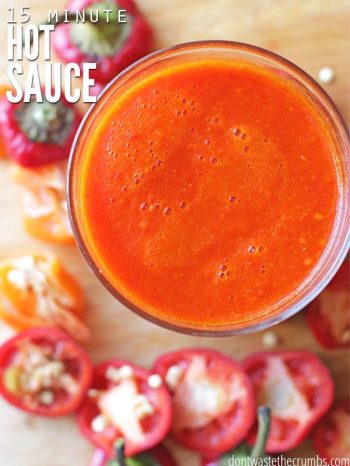
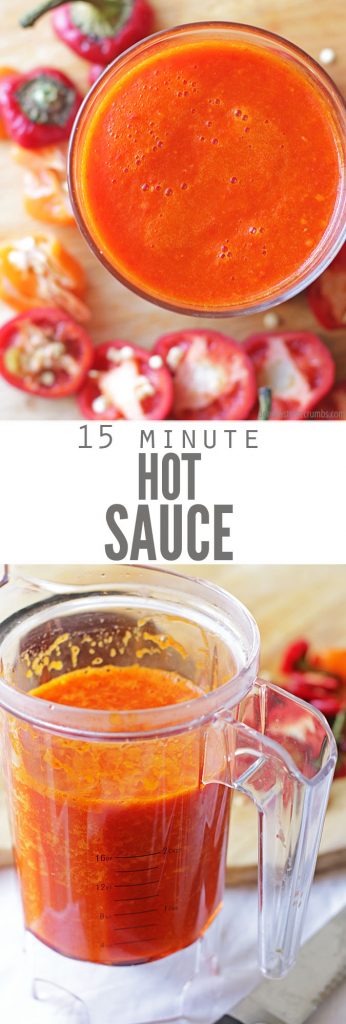




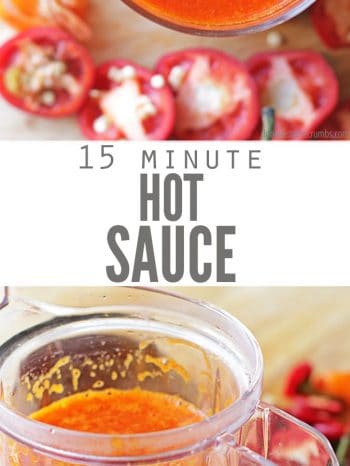
I was very skeptical that this could make good hot sauce but I had nothing better to do with the jalapeños, Serranos, and aji rico peppers bursting from my garden. OH MY GOD SO GOOD. So easy, and so delicious.
If I use roasted peppers, do I need to remove the skin after roasting?
Thanks.
Hi Gail,
It is best to remove the skins of your peppers. I usually leave the skins on really thin peppers. Hope this helps!
I’ve got some sauce that I made in a similar way from Ghost Peppers that is two years old and still taste great. It has been in the fridge the whole time. I plan to make more this year with Carolina Reapers but i’m going to boiling bath them to ensure longer shelf life and not have to take up room in the fridge.
Thanks for this. It seemed like a lot of work to make homemade hot sauce and then it only keeps for a week in the refrigerator. Plan to make some today.
Not really Todd. The vinegar and salt act as a perservative; as, to some extent, the pepper oil does too. I have never had a problem of spoilage in 3 years-and the sauce was used for 6 months or more.
Then why does it say to use within a week?
Hi Bill,
Our instructions for use for this recipe is to use it within one week to prevent spoilage. Hope this helps!
I never have any fresh peppers, so I use 1/8 tsp ground cayenne per pepper.
Always works for me in a pinch.